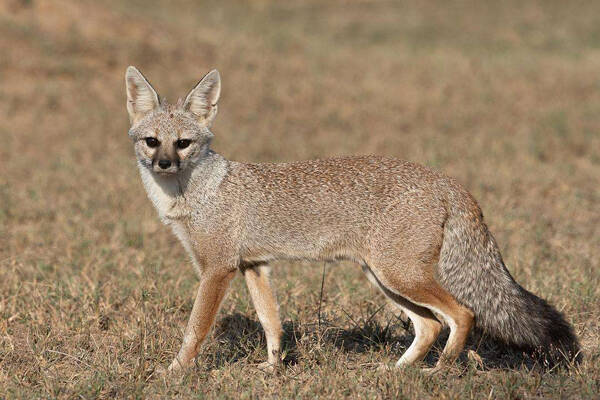Vulpes bengalensis
IUCN
LCBasic Information
Scientific classification
- name:Vulpes bengalensis
- Scientific Name:Vulpes bengalensis,Bengal Fox, Indian Fox
- Outline:Carnivora
- Family:Schizopoda Canidae Vulpes
Vital signs
- length:45-60cm
- Weight:2-4kg
- lifetime:6-8years
Feature
A fox species endemic to the Indian subcontinent
Distribution and Habitat
The Bengal fox is found in Bangladesh, India, Nepal and Pakistan.
The Bengal fox lives mainly in scrub and extremely arid areas of the Indian subcontinent, especially in the Himalayas and the Indus River basin. The species prefers dry, flat areas with undulating terrain, and is found in scrub and grassland habitats where it is easy to dig dens. The Bengal fox avoids dense forests, steep terrain, tall grasslands and true deserts. The species is relatively abundant in zones 3, 4 and 6 of the Indian biogeographic zone, where precipitation is low and vegetation is usually shrubs, thorns or dry deciduous forests. In peninsular India, the species is restricted to plains and open scrub.
Appearance
Bengal foxes are small foxes, 45-60 cm long, with a tail 25-36 cm long. They generally weigh 2-4 kg. They have a long snout, long pointed ears, and a tail that is about 50-60% of their body length. The back is gray, the belly is lighter, and the feet are brown or reddish brown. The tail is hairy with a black tip. The back of the ear is dark brown with black edges. The nose is hairless, the lips are black, and there are some small black spots on the snout. Different groups and seasons also have different fur colors.
They have a symmetrical body, slender limbs, and are toe-walking, which is conducive to fast running. The head and palate are pointed, the face is long, the nose tip is prominent, the ears are pointed and upright, the sense of smell is sensitive, and the hearing is well developed. The canine and carnassial teeth are well developed; the upper molars have obvious cusps, and the lower molars have a small cusp and heel tip on the inside; the crown diameter of the molars is gr
Details
Bengal fox (scientific name: Vulpes bengalensis) is also known as Bengal Fox, Indian Fox, and has no subspecies.

The preferred habitat of the Bengal fox is small open grasslands and thorny bushes, and they seem to avoid steep mountains and endless grasslands. Recent research reports show that the Bengal fox strongly prefers semi-arid and small grasslands as habitats. The Bengal fox mainly comes out at dawn and dusk. When the weather is hot, they hide in the grass or in the underground dens they dig. The dens dug by Bengal foxes are usually large and complex rooms and tunnels.
Bengal foxes mainly eat rodents, lizards, crabs, termites, insects, small birds and fruits. Like most foxes, Bengal foxes have a wide variety of vocalizations. Continuous calls are the most common, but others include roars, whimpers, sobs, etc.
Autumn is the mating season for Bengal foxes (usually October to November). The gestation period of female foxes is about 50-60 days, and an average of 2-4 cubs are born per litter. Both parents raise the cubs, but the mother fox is still the one who takes care of them. The cubs are weaned 3-4 months after birth and begin to contact the outside world. The mortality rate of young foxes is very high, especially in the first few months after birth. When the little fox grows to 5 months old, it is still suckling milk. Their teeth are gradually developing and sometimes they will accidentally bite their mother's nipples, and the female fox knows that the weaning period is approaching. In an artificial breeding environment, the life span of Bengal foxes is about 6-8 years.

Bengal foxes are endemic to the Indian subcontinent. Although widespread, they remain at low densities throughout their range, and populations are subject to significant fluctuations with prey. The Bengal fox is declining due to loss of short grassy scrub habitat to intensive agriculture and industrial development projects. However, the decline is not enough to place the species on the list of threatened species, so it is assessed as a species of least concern.
Listed in the 2012 IUCN Red List of Threatened Species, ver 3.1 - Low Concern (LC).
Listed in Appendix I, II and III of the Convention on International Trade in Endangered Species of Wild Fauna and Flora (CITES) Appendix III of the 2019 edition.
Protect wild animals and stop eating game.
Maintaining ecological balance is everyone's responsibility!








